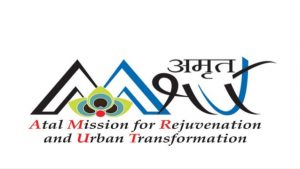2nd Phase AMRUT Mission:

The Prime Minister launched the second phase of Atal Mission for Rejuvenation and Urban Transformation (AMRUT 2.0).
- The Ministry of Housing and Urban Affairs (MoHUA) is the nodal ministry for the scheme.
- It is the continuation of the AMRUT mission launched in June 2015 to ensure that every household has access to a tap with the assured supply of water and a sewerage connection.
- AMRUT 2.0 aims to provide 100% coverage of water supply to all households in around 4,700 ULBs (Urban Local Bodies).
- It also seeks to promote Atmanirbhar Bharat through encouraging Startups and Entrepreneurs (Public Private Partnership).
- Objectives:
- It will build upon the progress of AMRUT to address water needs, rejuvenate water bodies, better manage aquifers, reuse treated wastewater, thereby promoting a circular economy of water.
- It will provide 100% coverage of sewerage and septage in 500 AMRUT cities.
- Recycling and reuse of treated wastewater is expected to cater to 20% of total water needs of the cities and 40% of industrial demand.
- Under the Mission, fresh water bodies will be protected from getting polluted to make natural resources sustainable.
- Pey Jal Survekshan will be conducted in cities to ascertain equitable distribution of water, reuse of wastewater and mapping of water bodies.
Performance of AMRUT Phase-I:
- 1.14 crore water tap connections have been provided taking total connections to 4.14 crore in AMRUT cities.
- Credit rating work has been completed in 470 cities. Of which, 164 cities have received Investable Grade Rating (IGR), including 36 cities with rating of A- or above.
- Rs 3,840 crore has been raised through Municipal Bonds by 10 ULBs. The Online Building Permission System has been implemented in 2,471 cities including 455 AMRUT cities.
- This reform has helped improve India’s rank in Ease of Doing Business in construction permits to 27 in Doing Business Report (DBR) 2020 of World Bank from 181 in 2018.
- 89 lakh conventional streetlights have been replaced with energy efficient LED lights, leading to estimated energy savings of 195 crore units per annum & reduction in CO2 emission by 15.6 lakh tons per annum.




